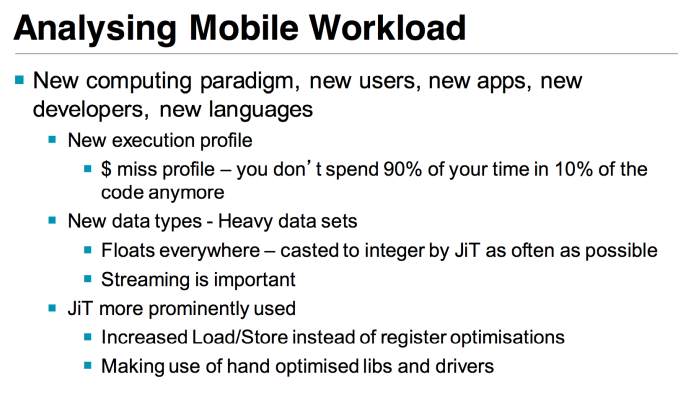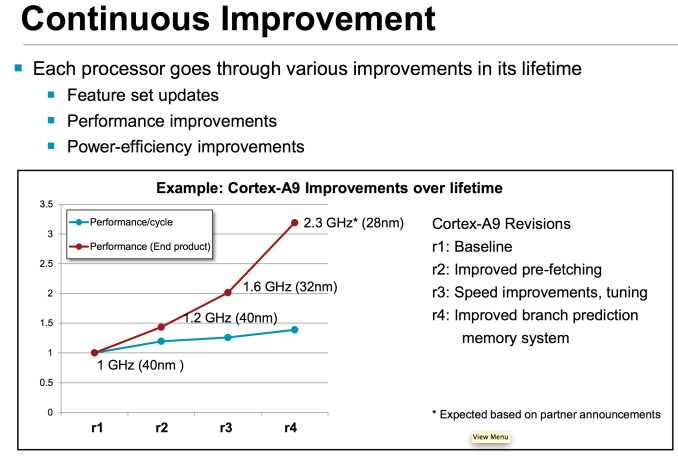The ARM Diaries, Part 2: Understanding the Cortex A12
by Anand Lal Shimpi on July 17, 2013 12:30 PM EST- Posted in
- CPUs
- Arm
- SoCs
- Cortex A12
Performance Expectations & Final Words
ARM’s Cortex A9 was first released to licensees back in 2009, with design work beginning on the core years before that. To say that the smartphone market has changed tremendously over the past several years would be an understatement. Many of the assumptions that were true at the time of the Cortex A9’s development are no longer the case. There’s far more NEON/FP code in use on mobile platforms, higher frequency of memory accesses and much heavier performance demands in general. While the Cortex A9 was a good design for its time, its weaknesses on the FP and memory fronts needed addressing. Thankfully, Cortex A12 modernizes the segment.
Although ARM referred to Cortex A9 as an out-of-order design, in reality it supported out-of-order integer execution with in-order FP and memory operations. ARM’s Cortex A12 moves to an almost completely OoO design. All aspects of the design have been improved as well. Although the Cortex A9 is expected to continue to ramp in frequency over the next year as designs transition to 28nm HPM and beyond, Cortex A12 should deliver much better performance in an more energy efficient manner.
At the same frequency (looking just at IPC), ARM expects roughly a 40% uplift in performance over Cortex A9. The power efficiency and area implications are more interesting. ARM claims that on the same process node as a Cortex A9, a Cortex A12 design should be able to deliver the same or better power efficiency. The design achieves improved power efficiency by throwing more die area at the problem; ARM expects a Cortex A12 implementation to be up to 40% larger than a Cortex A9. Just like the increasing performance of the Cortex A15 line of microarchitectures necessitates development of the Cortex A9/A12 line, the increasing size of this line drives up demand for the Cortex A7/A53 family below it.
ARM’s unique business model allows for the extreme targeting and customization of its microprocessor IP portfolio. If one of its cores gets too large (or power hungry), there’s always a smaller/more energy efficient option downstream.
The Cortex A12 IP has been finalized as of a couple of weeks ago and is now available to licensees for integration. The first designs will likely ship in silicon in a bit over a year, with the first devices implementing Cortex A12 showing up in late 2014 or early 2015. Whether or not the design will be too late once it arrives is the biggest unknown. Qualcomm’s Krait 300 core should provide the smartphone market with an alternative solution, but the question is whether or not the mobile world will need a Cortex A12 when it shows up. We always like to say that there are no bad products, just bad pricing. A more aggressively priced alternative to a Snapdragon 600 class SoC may entice some customers. Until then, the latest revision to the Cortex A9 core (r4) is expected to carry the torch for ARM. ARM also tells us that we might see more power optimized implementations of Cortex A15 in the interim as well.












65 Comments
View All Comments
crypticsaga - Wednesday, July 17, 2013 - link
Is it just me or have the arm architecture reviews become more interesting than the intel or amd ones?WhitneyLand - Wednesday, July 17, 2013 - link
Your tastes are changing. I used to read power supply and case reviews, now I usually don't even peek at the summary. I guess you could say some people are interested in where the action is, and while Intel is making bold moves (I still read Intel articles) there are still many things that we already know from previous reviews. ARM is still novel to us.jeffkibuule - Monday, July 22, 2013 - link
They are constantly evolving. Intel isn't experiencing hyper growth in performance anymore, instead optimizing for power which is far less sexy.lilmoe - Wednesday, July 17, 2013 - link
Cortex A12 is too late to the game. Too frustratingly so.name99 - Wednesday, July 17, 2013 - link
What game is that? ARM is in the business of making money. It will sell hundreds of millions of these to the developing world, and make money on each one.If you want to view low-power CPUs as porn, not a business, you should be spending your time watching Apple (and to a lesser extent, Qualcomm and, maybe one-day Intel) not ARM.
lilmoe - Wednesday, July 17, 2013 - link
I'm strictly speaking business, not porn, thank you. To me, Cortex A12 is addressing the same problem that Krait and Swift cores addressed (specifically in memory bandwidth), where competitors are clearly >2 years ahead by the time of availability. Look how "successful" A15 vendors are (/s) while Qualcomm is taking a huge share of the pie.big.LITTLE is proving too hard to implement. Samsung has succeeded in providing Apple with their needs when other fabs failed, all while having difficulties with their implementation of big.LITTLE. Samsung even ditched the CHEAPER licence of ARM's Mali GPU in favor of IT's solution. There's clearly a problem somewhere. Yes, Cortex A15 is faster, but "average" performance of Krait 200 compared with big.LITTLE (a15/a7) is VERY comparable. However, in heavy workloads, Cortex A15 consumes significantly more power.
ARM has this "view" on how the market "should" be heading, while the market is heading in a clearly different power-envelope/performance direction. Reason? Android. Cortex A9 is not powerful enough for Android, and A15 consumes too much power. I'm a big believer in power efficiency, but ARM seriously need to revise their power envelope charts. Cortex A15 should have been a target of the 20/22nm process, NOT 28nm. That's how demand is working now. Cortex A12 SHOULD HAVE BEEN prioritized over Cortex A15 on 28nm. OEMs (including Samsung) are preferring Snapdragons over Exynos 5 and Tegra 4 even on more power tolerable devices like tablets.
That said, even they're high performance Cortex A15 is seriously threatened by Krait 300 and Silvermont cores in power efficiency at relative performance. And by the time A57 is implemented, where do you think the competition will be?
Someday Intel? Dude, for $400, can either get a Windows RT ARM tablet, or a FULL Windows 8 tablet running Saltwell (and Silvermont in the very near future), which one would you pick? Android tablet you say? Guess what Samsung is doing now with their Tab 3 10.1.
Developing countries? Don't worry about those, Krait 200 cores will be too darn cheap in 2 years when A12 is ready to ship. Oh, they also have modem integration......
The business world works VERY differently from the world enthusiasts live in...
aryonoco - Wednesday, July 17, 2013 - link
You make very valid points, but you have a very developed-world-centric point of view.Yes A12 is too late, it is a response to Swift and Krait, and it is over two years too late. We'll have to wait a while still of course to see how it stacks up against its competition in 2015, but I agree with you in that it should have been prioritized, and it's late.
What you are missing however is that there is a huge swath of the market where ARM doesn't really have a competition. Swift and Krait are non-entities there, they are too expensive for your average Chinese OEM like Zopo or THL or Cube or FAEA (or many dozen others). These phones and tablets are now ruling China, India and south-east Asia, and they are all using Mediatek Cortex A7s in the phones, and Rockchip or Allwinner Cortex A9s in their tablets and Android sticks. These are huge markets, we are talking over 3.5 Billion people who live in these countries, and yes Samsung and Apple sell their phones there as well, but they are tiny (especially Apple). Something like 37% of ARM's Cortex A chips were produced by Mediatek alone in 2012, and no one in the developed world has even heard of them.
Sure Qualcomm is trying to play in this market, with their confusingly named Snapdragon S4 Play (which is just a cortex A5) but Mediatek beats it hands down both in performance and price. Modem integration you say? It just isn't a factor. They all have single band HSPA modems on 2100 Mhz, or at best dual band 850/2100 or 900/2100 and that's all that these markets care about. Oh and dual SIM, they really care about their dual SIM. No one cares about Qualcomm's fancy pants LTE modems, there are no networks to use them on!
Will you ever see Cortex A12 in a flagship Samsung or Apple or HTC product? Probably not, but that doesn't really matter. You'll see it in hundreds of millions of products that will line up on AliExpress and Taobao and that's where the vast bulk of the market is going to be.
parim - Thursday, July 18, 2013 - link
I completely agree with all your points, the sub 200$ android phone market in India is dominated by MediaTech.All of India is on 2100Mhz HSPA
Qualcomm/nvidia need to reduce their prices by a lot to prevent being completely washed away by the MediaTech Wave
Qwertilot - Thursday, July 18, 2013 - link
The other thing to remember is that ARM aren't in competition with Qualcomm, Apple etc. You could even reasonably argue that the existence of Krait meant they didn't need to cover that niche as urgently as the newer markets that the A15/57 etc can be aimed at.Folk like MediaTech must be a massive long term worry for everyone in the SoC market (and Intel trying to break into it) - at some point (reasonably soon?) the bulk of people even in the developed world might well decide that they've got 'enough' performance and then all those very cheap chips will be waiting to destroy margins. ARM are of course set up not to mind.
aryonoco - Thursday, July 18, 2013 - link
Of course you are right, ARM doesn't really view Krait and Swift as its competition... but just because ARM is happy to license its instruction set doesn't mean they like Krait and Swift. ARM gets a higher initial revenue when it licenses out its instruction set, but after that, the percentage that it gets on shipping Krait and Swift cores is far lower than what it gets from a straight implementation of one of its Cortex A designs... in ARM's ideal world, everyone would be implementing straight from its designs and giving it the higher percentage fee.And yes, MediaTek is a massive worry to everyone the big guys. There is also a price war happening between Chinese companies (Rockchip and Allwinner) and MediaTek (which is Taiwanese) right now, price of highest end products have come down by over a third since the start of the year... you can now buy MT's highest end 1.5 Ghz quad core A7 chip for $8... this is just crazy!
Of course ARM is sitting comfortable at the top, but the one company that can give ARM some headache is Imagination. They've been beating ARM in the embedded GPU space for a good while now, and now that they have a CPU architecture of their own... this is going to get very interesting. In the 90s, MIPS had a far better IPC than ARM, so if Imagination really is set to revive MIPS and get aggressive on price, it will be very interesting to watch, especially with over 95% of Android apps working just fine on MIPS. Pity no one is paying attention to that battle, AnandTech didn't even cover the launch of Warrior.